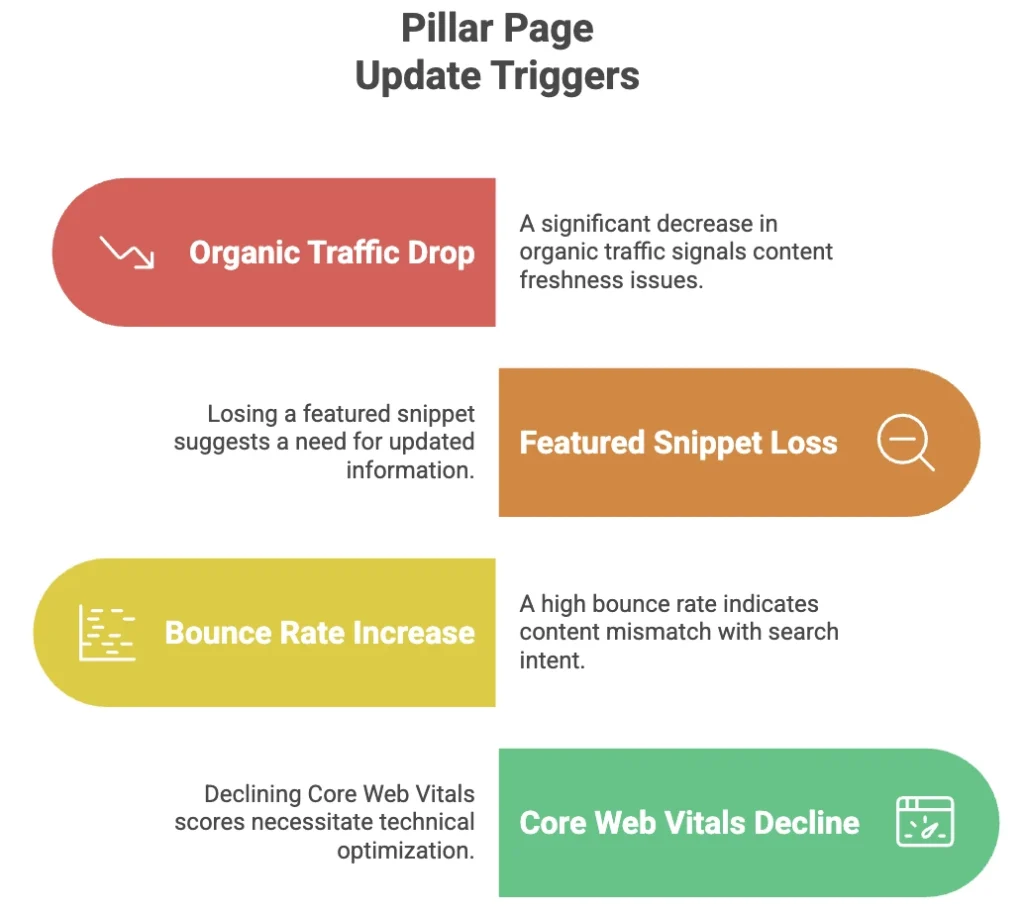Your pillar content should be refreshed every 6-12 months, but the real answer isn’t about calendar dates, it’s about performance signals, algorithm changes, and competitive moves that directly impact your startup’s customer acquisition cost (CAC) and search visibility.
Most growth-stage startups treat pillar pages like “set it and forget it” content. That’s a costly mistake. Your comprehensive topic pages are your highest-value SEO assets, often driving 30-40% of organic traffic and serving as the foundation for both Google rankings and AI-powered search results in ChatGPT, Perplexity, and Gemini.
Here’s exactly when to update your pillar content and how to do it without tanking your current rankings.
The Performance-Based Update Triggers
Update immediately when you see these signals:
- Organic traffic drops 15%+ over 30 days – This often indicates content freshness issues or new competitor content outranking you
- Featured snippet loss – If you lose a featured snippet position, your pillar content likely needs updated information or better structure
- Bounce rate increases above 70% – Users aren’t finding what they expect, suggesting your content no longer matches search intent
- Core Web Vitals scores decline – Google’s ranking factors change, and pillar pages need technical optimization to maintain visibility

Algorithm and Industry Triggers
Monthly monitoring should catch these update needs:
Search algorithm updates hit pillar content harder than other pages because they’re comprehensive and touch multiple ranking factors. When Google rolls out helpful content updates or E-E-A-T changes, your pillar pages need immediate attention, and can have an impact on your websites topical authority.
Industry shifts happen fast in startup-focused markets. If you’re targeting “AI SEO tools” and new products launch monthly, your pillar content becomes outdated quickly. Set up Google Alerts for your main keywords to catch these changes.
Competitive intelligence matters more for pillar content than regular blog posts. Use tools like Ahrefs or SEMrush to monitor when competitors publish comprehensive guides on your topics. If three competitors update their pillar content on “startup growth marketing” in one quarter, you’re falling behind.
The “Answer User Questions Immediately” Approach
Your pillar content should answer the questions real users are asking right now, not last year. Here’s how to stay current:
Reddit and community monitoring reveals changing pain points. Search r/entrepreneur, r/startups, and r/marketing weekly for new questions about your pillar topics. For example, recent discussions about AI content detection tools mean your “content marketing” pillar page needs updates about human-AI collaboration strategies.
Customer support ticket analysis shows you exactly what users don’t understand about your topic. If support gets 10+ questions about something your pillar page covers, that section needs rewriting or expansion.
Sales team feedback highlights knowledge gaps in your target audience. When prospects ask the same questions repeatedly, your pillar content should address those concerns more directly.
Technical Update Requirements
Internal linking structure needs quarterly reviews. As you publish new cluster content, your pillar pages should link to the most valuable recent pieces. Whenever you add a new cluster page to your content hub, update your links. New connections show your site is active and keep your important pages easy to find.
Schema markup and structured data require updates when Google introduces new markup types or when your content format changes. Rich snippets from pillar content drive significantly more clicks than standard listings.
Mobile optimization needs constant attention. Pillar pages are typically long-form content, and mobile user behavior changes faster than desktop patterns. If mobile bounce rates exceed desktop by 20%+, your pillar page needs UX improvements.
AI Search Optimization Updates
Traditional SEO updates aren’t enough anymore. Your pillar content needs optimization for generative engine optimization (GEO), ensuring AI models like ChatGPT and Perplexity cite your content in their responses.
Conversational query optimization means updating your pillar content to answer questions the way people ask AI assistants. Instead of just “What is growth marketing,” optimize for “How do I reduce CAC with growth marketing for my startup?”
Citation-worthy formatting helps AI models reference your content. Use clear headings, numbered lists, and data points that AI can easily extract and cite. When ChatGPT recommends growth marketing strategies, you want your pillar page to be the source.
Fact density and authority signals matter more for AI search than traditional SEO. Pack your pillar content with specific data points, case studies, and expert quotes that AI models recognize as authoritative sources.
Content Depth vs. Freshness Balance
Don’t update everything at once. Smart pillar content updates focus on specific sections rather than complete rewrites. This preserves your existing rankings while improving relevance.
Expand successful sections that already drive traffic and engagement. If your “startup CAC calculation” section performs well, add more examples, tools, or case studies rather than rewriting from scratch.
Prune outdated information systematically. Remove references to discontinued tools, outdated statistics, or strategies that no longer work. This improves content quality without major structural changes.
Seasonal and Event-Based Updates
Industry conference seasons provide perfect update opportunities. If you’re targeting startup marketing, update your pillar content after major events like SaaStr, Inbound, or WebSummit with new insights and trends.
Quarterly business cycles affect search behavior. B2B startups see different search patterns at year-end versus Q1 planning season. Update your pillar content to address seasonal concerns and planning cycles.
Product launch cycles in your industry create new subtopics for your pillar content. When major platforms release new features (like LinkedIn’s AI tools or Google’s search updates), your marketing pillar pages should incorporate these developments.
The Update Process That Preserves Rankings
Start with performance analysis. Before changing anything, document current rankings, traffic patterns, and conversion rates from your pillar content. This baseline helps you measure update success.
Use the “section-by-section” approach. Update 20-30% of your pillar content at a time, then monitor performance for 2-3 weeks before making additional changes. This prevents ranking volatility.
Maintain URL structure and core heading hierarchy. Google associates rankings with specific URL patterns and content structure. Major changes can temporarily hurt visibility.
Update publish dates strategically. Some SEOs recommend against updating publish dates, but for pillar content, fresh timestamps can boost click-through rates and signal content freshness to both users and algorithms.
Common Update Mistakes to Avoid
Over-optimization kills good content. Don’t stuff new keywords or completely rewrite sections that already perform well. Incremental improvements work better than dramatic overhauls.
Ignoring user intent evolution is expensive. The same keyword can mean different things as markets mature. “AI marketing tools” meant something different in 2022 than 2025. Update your pillar content to match current search intent.
Forgetting cluster content updates wastes pillar page improvements. When you update pillar content, review and update related cluster articles to maintain topic relevance and internal linking value.
The bottom line: treat pillar content updates like product iterations. Data-driven improvements, user feedback integration, and systematic testing beat random refresh schedules every time.
Frequently Asked Questions
How often should I completely rewrite pillar content versus making incremental updates?
Complete rewrites should only happen every 18-24 months or when major industry shifts occur. Incremental updates every 6-12 months preserve rankings while keeping content fresh. Focus on expanding successful sections and updating outdated information rather than starting from scratch.
Will updating pillar content hurt my current Google rankings?
Not if done correctly. Update 20-30% of content at a time, maintain your URL structure and main headings, and avoid keyword stuffing. Monitor rankings for 2-3 weeks after each update batch. Most well-executed updates improve rankings within 30-60 days.
How do I know if my pillar content needs updates for AI search optimization?
est your content by asking questions about your topic in ChatGPT, Perplexity, and Gemini. If your content isn’t being cited or mentioned, you need better fact density, clearer formatting, and more authoritative data points. AI models prefer content with specific examples and structured information.
How do I know if my pillar content needs updates for AI search optimization?
Test your content by asking questions about your topic in ChatGPT, Perplexity, and Gemini. If your content isn’t being cited or mentioned, you need better fact density, clearer formatting, and more authoritative data points. AI models prefer content with specific examples and structured information.
Should I update pillar content based on seasonal search trends?
Yes, especially for B2B topics. Add seasonal sections or callouts rather than rewriting core content. For example, add “year-end planning” sections to marketing pillar pages in Q4, then update with “Q1 strategy” content in January. This captures seasonal search volume without disrupting evergreen content.
What’s the biggest mistake startups make when updating pillar content?
Treating updates like new content creation. Successful pillar updates build on existing performance rather than starting over. Analyze which sections already drive traffic and engagement, then expand those areas. Don’t fix what isn’t broken, enhance what’s already working.
